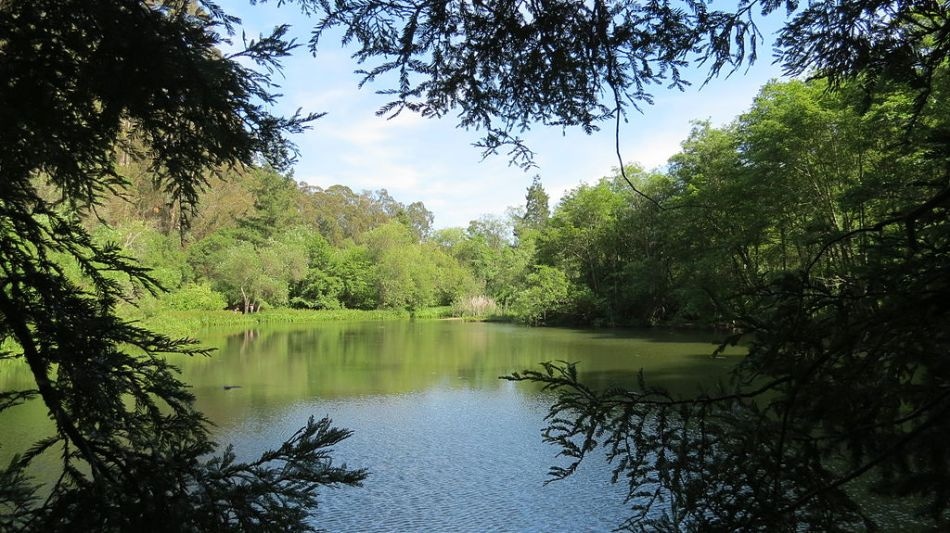Mar 29 2018
A new enzyme that can be used for the microbial production of a renewable substitute to petroleum-based toluene has been discovered by scientists from the Lawrence Berkeley National Laboratory (Berkeley Lab) and the U.S. Department of Energy Joint BioEnergy Institute (JBEI). Petroleum-based toluene is extensively used as an octane booster in gasoline, with a global market of 29 million tons per year.
 This lake in Berkeley, California was one source of the toluene-producing enzyme (phenylacetate decarboxylase) discovered in the JBEI study. (Image credit: Chickmarkley)
This lake in Berkeley, California was one source of the toluene-producing enzyme (phenylacetate decarboxylase) discovered in the JBEI study. (Image credit: Chickmarkley)
Outcomes of a research headed by Harry Beller, Berkeley Lab senior scientist and scientific lead at JBEI, were reported on Monday, March 26, 2018, in the Nature Chemical Biology journal. Andria Rodrigues and Kamrun Zargar from JBEI are the other lead co-authors of the study.
JBEI, and the wider community of biofuel scientists, specifically focus on the synthesis of commercially and industrially relevant chemicals and fuels from renewable resources (for example, lignocellulosic biomass) instead of petroleum. The enzyme discovered in this research will lead to the first-ever microbial synthesis of bio-based toluene, and actually, the first ever microbial synthesis of any known aromatic hydrocarbon biofuel.
The discovery of the enzyme is the result of the extensive research performed on two highly distinctive microbial communities that synthesized toluene. One of the communities consisted of microbes from lake sediment, while the other consisted of microbes from sewage sludge. Due to the fact that environmental microbes act as a reservoir of enzymes that initiate an exceptionally diverse set of chemical reactions, it is not uncommon for researchers in the field of biotechnology to source enzymes from nature.
Beller got the inspiration to analyze bio-based toluene upon reading literature reports from the 1980s that evinced the biosynthesis of microbial toluene in anoxic lake sediments. Although there have been several reports of bacterial toluene synthesis from that time, for decades, there have been no clues about the enzyme that initiates this biochemically difficult reaction.
Phenylacetate decarboxylase, the toluene-producing enzyme discovered in this research, is part of a class of enzymes called glycyl radical enzymes (GREs). Only in the 1980s did researchers start to identify GREs, and phenylacetate decarboxylase is only the eighth known GRE reaction type to have been found out and characterized since then. Yet, metagenomic evidence furnished in the JBEI research and others indicate that many more GREs occur in nature, yet to be characterized.
The radical nature of GREs enables them to initiate chemically difficult reactions, for instance, anaerobic decarboxylation of phenylacetate to generate toluene. Apart from their potential biotechnological applications, several known GREs play a vital role in maintaining the human health and exist inside the human gut microbiome.
In the case of this study, the process of enzyme discovery was not only difficult but also non-traditional. Initially, the scientists started analyzing a bacterial species known to produce toluene. However, when those reports seemed irreproducible, the researchers searched the environment for toluene-producing cultures—particularly anoxic lake sediment and municipal sewage.
All enzyme discovery projects are challenging. But moving from discovery in a single bacterial species to discovery in a complex microbial community from sewage sludge or lake sediments, was more difficult by orders of magnitude. This study became a needle-in-a-haystack search for the toluene-producing enzyme in a candidate pool of hundreds of thousands of enzymes.
Harry Beller
As a matter of fact, each of the metagenome investigations showed that these microbial communities consisted of over 300,000 genes, which is equivalent to over 50 bacterial genomes. One more difficulty was that the anaerobic microbial communities and several of their enzymes were sensitive to oxygen, urging the researchers to regulate enzymes and cultures under strictly anaerobic conditions.
The discovery process integrated protein purification methods adopted by biochemists for many decades (for example, fast protein liquid chromatography) with modern metagenomic, metaproteomic, and associated bioinformatic analyses, where some of the analyses were performed in partnership with the Joint Genome Institute, a DOE Office of Science User Facility. A crucial element in the discovery process was the validation of the scientists’ predictions of the toluene biosynthesis enzyme by means of experiments using highly controlled assays including purified proteins.
Following is an interesting query that emerges from this study: Why does a bacterium synthesize toluene? Although the scientists do not have the definitive answer to this query, in the paper, they have presented two hypotheses. One probability is that the bacterium synthesizes toluene as a toxin to outcompete other microbes in its environment. The other probability is that the phenylacetate decarboxylase (or toluene-producing) reaction offers an approach for the bacterium to govern its internal pH in a slightly acidic, fermentative environment.
Beller and his team are of the view that their research outcomes are of significance to basic and applied science. From a biochemical point of view, the research extends the known catalytic range of GREs. From a biotechnological point of view, it will allow first ever biochemical production of an aromatic fuel hydrocarbon from renewable resources.
We have so much to learn about the extraordinary metabolic diversity of bacteria. Through eons of evolution, nature has devised enzymes that can catalyze difficult chemical reactions, and as we discover these, we can harness them for biotechnology.
Harry Beller
JBEI is a DOE Bioenergy Research Center funded by DOE’s Office of Science. Yu-Wei Wu, Avneesh K. Saini, Renee M. Saville, Jose H. Pereira, Paul D. Adams, Susannah G. Tringe, Christopher J. Petzold, and Jay D. Keasling are the other co-authors of the paper titled “Discovery of enzymes for toluene synthesis from anoxic microbial communities.”